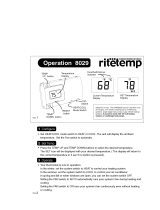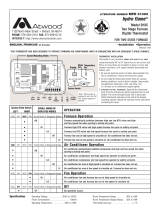
Pub. No. 18-HD29D3-4 17
Installer’s Guide
Optional Humidistat Accessory
The optional humidistat connects to subbase terminals H1
and H2 and opens on a rise in humidity. The Comfort
Control provides dehumidification only during cooling mode
operation as described below.
• Variable Speed Dehumidification – BK
Enabled
Extends the compressor runtime by two minutes
to remove additional moisture from the indoor air.
Defeats the blower turn-off delay.
Reduces the indoor air flow to 80% when the room
temperature is within 2 degrees of the setpoint
and when the room temperature is below the
setpoint.
• Non-Variable Speed Dehumidification – BK
Disabled
Extends the compressor runtime by two minutes
to remove additional moisture from the indoor air.
Defeats the blower turn-off delay.
Applies the greater of the blower turn-on delay, or
30 seconds maximum blower turn-on delay based
on how long the compressor has been off.
Wet Heat
A hot water coil can be applied with a variable speed or
non-variable speed indoor unit to provide heat or to provide
auxiliary heat for heat pumps. With either type of
equipment, the blower turn-on and turn-off delays apply to
the G output (ISU Steps 38 & 39).
• Variable Speed Wet Heat – BK Enabled
W1 turns on continuously for first stage and the
air flow is modulated based on the calculated load.
W2 is duty cycled for second stage based on the
calculated load while the air flow remains at
100%. The air flow during the fan off delay is at
35%.
• Non-Variable Speed Wet Heat – BK Disabled
W1 and W2 are duty cycled the same as for electric
heat operation.
Auxiliary Heat Lockout
Enabled by selecting an outdoor temperature. None of the
installed auxiliary heat stages will turn on during heating
operation above the selected outdoor temperature. During
defrost, this outdoor temperature setting is ignored and
the Defrost Heater Balance Point outdoor temperature
thresholds are used instead.
Defrost Heater Balance Point Control
A separate outdoor temperature turn-on threshold can be
chosen for each installed heater stage during defrost. If not
enabled, that particular heater stage will be energized
during every defrost cycle independent of the outdoor
temperature. Once the defrost cycle terminates, the
comfort control load calculation will resume duty cycle
control of the heater stages. During defrost, the comfort
control will not cycle the heat pump off unless an indoor
temperature overshoot of 2.5 degrees or more above the
heating setpoint occurs.
Dual Fuel (Heat Pump with Fossil Fuel Auxiliary Heat)
NOTE: No external dual fuel kit (e.g. TAYPLUS103A) is
required for use with this Comfort Control. During the
transition from furnace operation to heat pump operation,
there is a minimum comfort control time delay of 45
seconds between the furnace turning off and the heat pump
turning on.
RESTRICTED MODE - (Requires Outdoor
Temperature Sensor)
The Heat Pump Restricted Mode Outdoor Temperature
changeover point (ISU Step 43) must be set at or above the
application or economic balance point of the system.
At any temperature above the Heat Pump Restricted Mode
Outdoor Temperature the comfort control will first attempt
to satisfy the heating load by operating the heat pump. If
the heat pump alone cannot satisfy the load, the comfort
control will transition to furnace operation and will turn off
the heat pump. The furnace may operate continuously or it
may cycle on and off as required to balance the load.
When the outdoor temperature drops below the ISU Step
43 setting, the comfort control will operate only the furnace
and the heat pump will be off. When the outdoor
temperature rises above the setting of the Resume Heat
Pump Operation Outdoor Temperature (ISU Step 44), the
system returns to heat pump operation if the building load
is relatively low.
The outdoor temperature sensor reading is compared to the
outdoor temperature changeover point once every 10
minutes. The Resume Outdoor Temperature can be set no
closer than 4 degrees above the Restricted Mode Outdoor
Temperature.
Placing the comfort control in Emergency Heat mode
converts the system to furnace only operation.
NOTE: Economic Balance Point is the outdoor
temperature at which it is more economical to use the
alternate fuel energy than the primary electric heat pump
energy. Application Balance Point is the outdoor
temperature below which the heat pump alone cannot
handle the load.
UNRESTRICTED MODE -
If the building load is relatively low such that the heat
pump alone can hand the building load, the comfort control
will operate the heat pump to maintain the room
temperature at the setpoint, independent of the outdoor
temperature.
If the heat pump cannot handle the building load, the
comfort control will turn the heat pump off and will operate
the furnace. The furnace may operate continuously or it
may cycle on and off as required to balance the load.
Transition back to heat pump operation will occur when the
building load returns to a relatively low level.
Placing the comfort control in Emergency Heat mode
converts the system to furnace only operation.





















